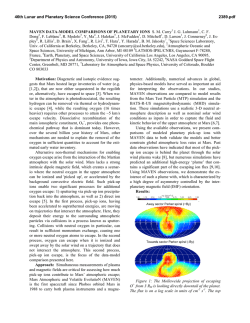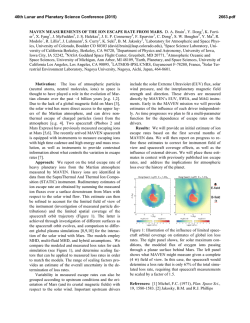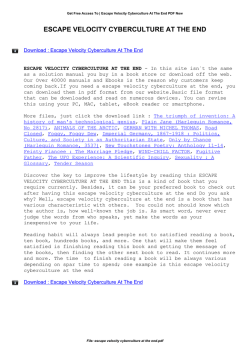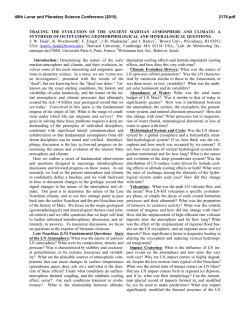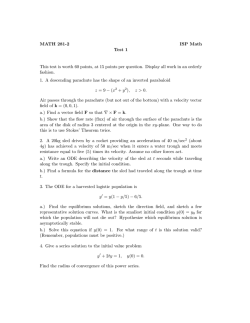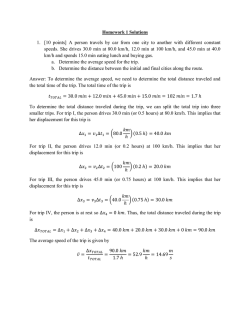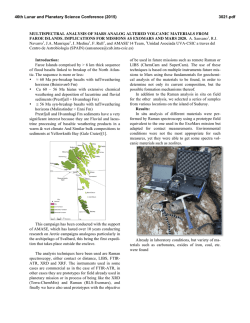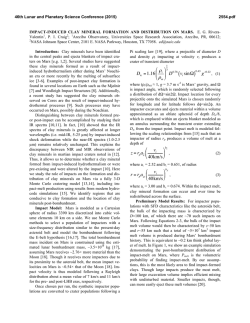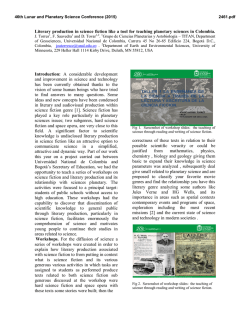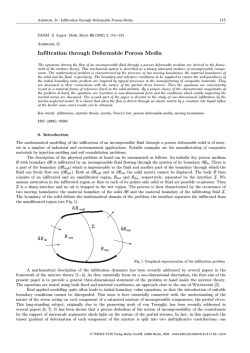
PLANETARY IMPACTS AND ATMOSPHERIC ESCAPE. D. G.
46th Lunar and Planetary Science Conference (2015) 1145.pdf PLANETARY IMPACTS AND ATMOSPHERIC ESCAPE. D. G. Korycansky, CODEP, Department of Earth and Planetary Sciences, University of California, Santa Cruz CA 95064 , D. C. Catling, Department of Earth and Space Sciences, University of Washington, K. J. Zahnle , Planetary Systems Branch, NASA Ames Research Center. One of the key features of Earth-sized planets in this and other systems is the presence or absence of an atmosphere. Among other things it is likely that an atmosphere is required for habitablity, at least on the surface of the planet. Assuming that an atmosphere forms on a planet, the next question is whether the atmosphere is stable, or whether it will escape. Atmospheres may escape by thermal or non-thermal means, or they may be eroded by impacts. Placing Solar System bodies on a diagram in which the typical impact velocity vimp onto that object is plotted against the escape velocity vesc from the object suggests that vimp /vesc ∼ 5 marks a dividing line between bodies with atmospheres and those without [1]. This suggests that there is a possible criterion for impact erosion to act as an effective means of removing an object’s atmosphere. However, there is a degeneracy: in the solar system vimp is roughly proportional to the orbital velocity vorb , so that high impact velocities are found for bodies orbiting close to the Sun; such objects also suffer large radiative fluxes. Thus the correlation between impact velocity and presence of an atmosphere may only reflect the outcome of other escape mechanisms that are dependent on radiative flux. We are investigating atmospheric escape with the aim of disentangling the possible degeneracy between the effects of impact erosion and the other mechanisms. This particular abstract reports on some preliminary results of the project to assess the effectiveness of impact erosion as a planetary loss mechanism. We are carrying out a suite of impact simulations across a range of parameters that will quantify this effect. Hydrodynamic modeling Impact simulations can be divided between “local” and “global” cases depending on the geometry of the impact, chiefly the impactor size relative to the target planet and the depth of the atmosphere compared to the planet’s radius. The calculations discussed here are local: the curvature of the planet and the radial dependence of the gravitational field are neglected. The computational domain is a cartesian box: the calculations are three-dimensional. Physical parameters of the simulations include the targetplanet properties: three planetary environments will be used. Parameters include the gravitational field (vertical gravity g) and the escape velocity that characterize the target. Additionally the surface pressure of the atmosphere and its scale height are set, the latter determined by the atmospheric composition and temperature. This in turn sets the altitude of the exobase, above which material is assumed to move ballistically. The parameters of the impactor are its diameter and velocity (specified in terms of the assumed escape velocity); the impactor angle is set to θ = 45◦ from the vertical. We are carrying out the local-scale simulations using the Figure 1: Sample timestep of a local-scale impact modeled with the CTH hydrocode. The figure shows density on a logarithmic scale (10−6 < ρ < 1 gm cm−3 ) at t = 60 s after the impact of a d = 36.8 km object at 20 km s−1 (4 × vesc ) into the “Mars” target. CTH hydrocode from Sandia National Laboratory [2]. CTH is a highly advanced code widely used in the planetary science community. It utilizes adaptive mesh refinement to concentrate computational resources at locations of physical interest in the simulation, such as shock fronts and material interfaces. In addition, it makes use of material strength models and advanced tabular equations of tabular such as ANEOS and the SESAME library from Los Alamos National Laboratory. The full project will examine impacts into three targets: Mars-like (g = 370 cm s−2 , vesc = 5.0 km s−1 ), Earth-like (g = 980 cm s−2 , vesc = 11.0 km s−1 ), and a “super-Earth” (g = 2411 cm s−2 , vesc = 23.5 km s−1 ) that matches conditions for an exoplanet of 8M⊕ . The surface pressures are Psur f = 1, 10, and 100 bar. For these first set of calculations we also assume an isothermal CO2 atmosphere at 300K, leading to exobase altitudes Hx ∼ 400, 150, and 60 km for the “Mars”, “Earth”, and “Super-Earth” cases, respectively. Impactor diameters will be di = 4.6, 17, and 36.8 km, and impact velocities are parameterized in terms of the escape velocity: vi /vesc = 2, 4, 6, and 8. Computation domain sizes are based on the maximum of either the transient crater diameter from the impact or the exobase altitude. Likewise the simulation runtimes are based on the maximum crater formation time or the time for impact ejecta oving at vesc to reach the exobase altitude. Both the impact and the target have made of basalt; a simple material model (“geo”) in CTH is applied, with a nominal yield strength 46th Lunar and Planetary Science Conference (2015) .1 .01 Some Preliminary Results "Mars" .001 me/mi .0001 .1 .01 1145.pdf Psurf = 1 bar Psurf = 10 bar Psurf = 100 bar "Earth" .001 .0001 2 4 6 8 v/vesc Figure 2: The ratio of escaping atmospheric mass me to the impactor mass mi = 7.5 × 1016 kg is shown for “Mars” and “Earth” calculations as a function of the impactor velocity to escape velocity ratio vi /vesc , for the three values of surface pressure Psur f , all for the impactor diameter di = 36.8 km. Filled triangles: Psur f = 1 bar. Filled squares: Psur f = 1 bar. Filled circles: Psur f = 1 bar. Top panel: “Mars” target. Bottom panel: “Earth” target. of 109 cm2 s−2 . Post-impact analysis yields fluxes of material moving at escape speed or faster through the boundaries (chiefly the upper boundary at z = Hx ); we integrate the flux to get the total amount of escaping material. Although we track three kinds of material (impactor, target surface, atmosphere), here we report only on the last (escaping atmosphere). We have carried out and analyzed about two dozen calculations so far. A sample timestep from one the calculations is shown in Fig. 1. The figure shows the density on a logarithmic scale (10−6 < ρ < 1 gm cm−3 ) at t = 60 s after the impact of a d = 36.8 km object at 20 km s−1 (4 × vesc ) into the “Mars” target. Completed analysis of runs at the time of writing is shown in Fig. 2, where the ratio of escaping atmospheric mass me to the impactor mass mi = 7.5 × 1016 kg is shown for our “Mars” and “Earth” calculations as a function of impactor velocity to escape velocity ratio vi /vesc for the three values of surface pressure Psur f , all for the impactor diameter di = 36.8 km. Looking at Fig. 2, several results are evident, at least at a tentative level. 1) The ratio of escaping mass to impactor mass (me /mi ) decreases by approximately an order of magnitude between the “Mars” and “Earth” cases; it is not clear whether this is due to the increased gravity or the increased escape velocity between the two cases. 2) Escaping mass generally increases with surface pressure (which is equivalent to atmospheric density for these atmospheres which all have the same temperature). Finally, 3) escaping mass does not appear to systematically increase with escape velocity, an unexpected result that contradicts some results in the literature [3-5]. More work (simulations and analysis) will be required to assess the robustness of this result and check its correctness. Acknowledgments This work was supported by NASA Planetary Atmospheres Program award NNX14AJ45G. Computations were carried out on the NASA Pleiades NAS cluster at NASA Ames. References [1] Catling, D. and Zahnle, K. 2013. 44th Lunar Planet. Sci. Conf., abstract 2665. [2] McGlaun, J. M., et al., 1990. Int. J. Impact Engr. 10, 351-360. [3] Hamano, K., Abe, Y., 2010. Earth Planets Space 62, 599-610 [4] Korycansky, D. G., Zahnle, K. J., 2011. Icarus 211, 707-721. [5] Shuvalov, V., 2009. Meteorit. Planet. Sci. 44, 1095-1105.
© Copyright 2025
